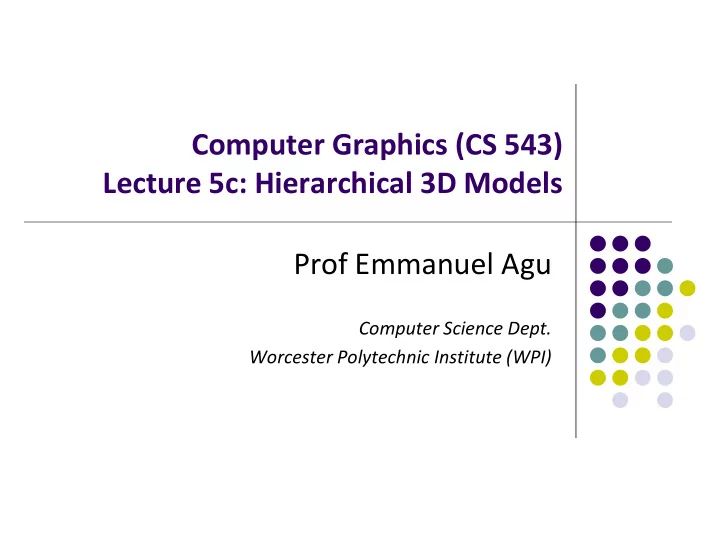

Computer Graphics (CS 543) Lecture 5c: Hierarchical 3D Models Prof Emmanuel Agu Computer Science Dept. Worcester Polytechnic Institute (WPI)
Instance Transformation Start with unique object (a symbol ) Each appearance of object in model is an instance Then scale, orient, position (instance transformation) Instance Symbol
Symbol-Instance Table Approach 1: store intances + instance transformations
Problems with Symbol-Instance Table Symbol-instance table does not show relationships between parts of model Consider model of car Chassis (body) + 4 identical wheels Two symbols Relationships: Wheels connected to chassis Chassis motion determined by rotational speed of wheels
Structure Program Using Function Calls? car(speed) { Chassis chassis() wheel(right_front); wheel(left_front); wheel(right_rear); wheel(left_rear); Left front Left back } wheel wheel Fails to show relationships between parts Explore graph representation 5
Graphs Set of nodes + edges (links) Edge connects a pair of nodes Directed or undirected Cycle : directed path that is a loop edge node loop 6
Tree Graph in which each node (except root) has exactly one parent node A parent may have multiple children Leaf node: no children root node leaf node 7
Tree Model of Car 8
Hierarchical Transforms Robot arm: Many small connected parts Attributes of parts (position, orientation, etc) depend on each other A Robot Hammer! hammer Upper arm lower arm base
Hierarchical Transforms Object dependency description using tree structure Root node Base Object position and orientation can be affected by its parent, grand-parent, grand-grand-parent Lower arm … nodes Upper arm Hierarchical representation is known as a Scene Graph Leaf node Hammer
Transformations Two ways to specify transformations: (1) Absolute transformation: each part transformed independently (relative to origin) Translate the base by (5,0,0); Translate the lower arm by (5,0,0); Translate the upper arm by (5,0,0); y … x z
Relative Transformation A better (and easier) way: (2) Relative transformation: Specify transformation for each object relative to its parent Step 1: Translate base and its child nodes by (5,0,0);
Relative Transformation Step 2: Rotate the lower arm and all its descendants by - 90 degrees, relative to the base’s local y axis y y z x x z
Relative Transformation Relative transformation using scene graph Base Translate (5,0,0) Lower arm Rotate (-90) about y axis Upper arm Apply all the way down Apply all the way Hammer down
Hierarchical Transforms Using OpenGL Translate base and all its descendants by (5,0,0) Rotate lower arm and its descendants by -90 degree about local y ctm = LoadIdentity(); Base … // setup your camera ctm = ctm * Translatef(5,0,0); Lower arm Draw_base(); Upper arm ctm = ctm * Rotatef(-90, 0, 1, 0); Draw_lower _arm(); Hammer Draw_upper_arm(); Draw_hammer();
Hierarchical Modeling For large objects with many parts, need to transform groups of objects Need better tools Need matrix stack Upper arm Torso Lower arm Upper leg Lower leg
Hierarchical Modeling Previous CTM had 1 level Hierarchical modeling: extend CTM to stack with multiple levels using linked list Manipulate stack levels using 2 operations pushMatrix popMatrix
PushMatrix PushMatrix( ): Save current modelview matrix (CTM) in stack Positions 1 & 2 in linked list are same after PushMatrix Before PushMatrix After PushMatrix 1 0 0 0 1 0 0 0 Current top Current top 0 2 0 0 0 2 0 0 Of CTM stack Of CTM stack 0 0 3 0 0 0 3 0 0 0 0 1 0 0 0 1 1 0 0 0 0 2 0 0 Saved copy of 0 0 3 0 matrix at CTM top 0 0 0 1
PushMatrix Subsequent Rotate, Scale, Translate change only top matrix E.g. ctm = ctm * Translate (3,8,6) After PushMatrix 1 0 0 0 1 0 0 3 Translate(3,8,6) applied 0 2 0 0 0 1 0 8 only to current top 0 0 3 0 0 0 1 6 Of CTM stack 0 0 0 1 0 0 0 1 1 0 0 0 0 2 0 0 Matrix in second position saved. Unchanged by Translate(3,8,6) 0 0 3 0 0 0 0 1
PopMatrix PopMatrix( ): Delete position 1 matrix, position 2 matrix becomes top After PopMatrix Before PopMatrix 1 0 0 0 1 5 4 0 Current top 0 2 0 0 0 2 2 0 Current top Of CTM stack Of CTM stack 0 0 3 0 0 6 3 0 0 0 0 1 0 0 0 1 Delete this matrix 1 0 0 0 0 2 0 0 0 0 3 0 0 0 0 1
PopMatrix and PushMatrix Illustration • Note: Diagram uses old glTranslate, glScale, etc commands. Deprecated!! • We want same behavior though Apply matrix at top of CTM to vertices of object created Ref: Computer Graphics Through OpenGL by Guha
Humanoid Figure Upper arm Torso Lower arm Upper leg Lower leg 22
Building the Model Draw each part as a function torso() left_upper_arm(), etc Upper arm Transform Matrices: transform of node wrt its parent M lla E.g. M lla positions left lower arm Lower arm with respect to left upper arm Stack based traversal (push, pop) 23
Draw Humanoid using Stack figure() { save present model-view matrix PushMatrix() torso(); draw torso 24
Draw Humanoid using Stack figure() { PushMatrix() torso(); (M h ) Transformation of head Rotate (…); Relative to torso head(); draw head 25
Draw Humanoid using Stack figure() { PushMatrix() torso(); Rotate (…); head(); PopMatrix(); Go back to torso matrix, and save it again PushMatrix(); (M lua ) Transformation(s) of left Translate(…); upper arm relative to torso Rotate(…); left_upper_arm(); draw left-upper arm …….. 26 // rest of code()
Complete Humanoid Tree with Matrices Scene graph of Humanoid Robot
VRML Scene graph introduced by SGI Open Inventor Used in many graphics applications (Maya, etc) Virtual Reality Markup Language Scene graph representation of virtual worlds on Web Scene parts can be distributed across multiple web servers Implemented using OpenGL 28
References Angel and Shreiner, Interactive Computer Graphics (6 th edition), Chapter 8
Recommend
More recommend